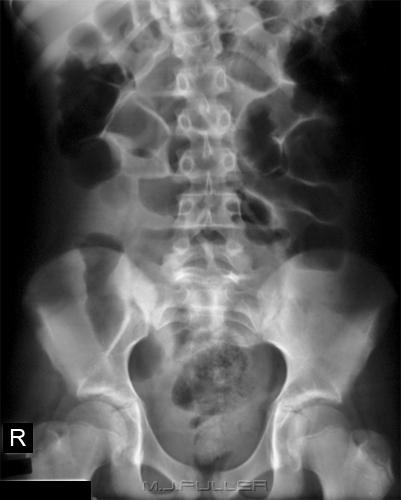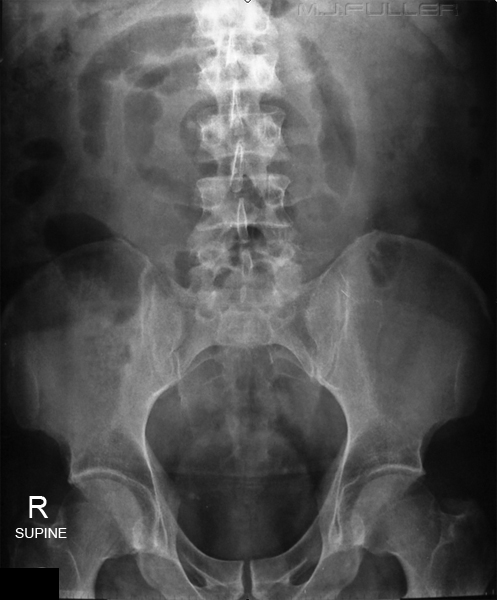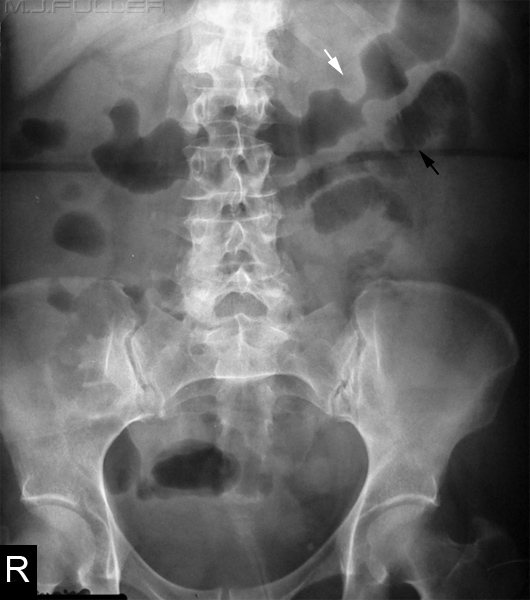The Abdominal Plain Film- Ileus
The abdominal plain film is often the first port of call in imaging of the acute abdomen. It can be somewhat of a gatekeeper in deciding who proceeds to CT or Ultrasound or for other procedures. A definitive diagnosis of ileus can be particularly difficult. This page examines aspects of diagnosis of ileus on plain films.
Definition of Terms
Ileus
| |
Motility Disorder
This term refers to abnormal motility of bowel contents without specifying whether it is obstructive or non-obstructive in nature.
Can a SBO be Differentiated from an Ileus on Plain Film?
The hallmark of small bowel obstruction is the presence of gaseous loops of small bowel which are distended over 30mm. The absorptive capacity of the small bowel is so great that even extreme amounts of air swallowing will not distend normal small bowel.
The presence of dilated loops of small bowel is not a guarantee that the patient is obstructed. Correlation with patient history and clinical signs can assist in arriving at a more specific diagnosis. The difficulty in differentiating obstruction from ileus has led some radiologists to use the blanket term "motility disorder" when describing dilated loops of bowel.
There is a very good discussion on obstruction vs ileus in paediatrics here <a class="external" href="http://www.hawaii.edu/medicine/pediatrics/pemxray/v3c18.html" rel="nofollow" target="_blank">http://www.hawaii.edu/medicine/pediatrics/pemxray/v3c18.html</a>
Note the logical process of arriving at a probable diagnosis.
Generalised Adynamic Ileus
Reflex Ileus
Reflex ileus refers to a secondary ileus in response to some type of insult. The causes of reflex ileus are numerous including abdominal inflammations and infections, chemical and pharmacological causes, trauma and abscess.
Localised Ileus (Sentinel Sign)
Clinical ContextPatient has renal colic
Other ImagingThe patient proceeded to have a CT abdomen where a 5.4cm left renal stone was found with left upper renal tract obstruction with moderate left hydronephrosis.CommentIn the absence of any other patient information, this image suggests nothing specific. Knowing that the patient has renal colic raises the possibility that the patient has a reflex ileus which is causing the prominent central small bowel loops. The renal stone and hydronephrosis found on CT support this finding.
Normal air-filled bowel tends to have a random, faceted, tessellated appearance rather than an organised non-random appearance
Check here for more information on the normal appearances of small bowel
Summary
Ileus can be a difficult diagnosis on abdominal plain film, particularly if the clinical context is not known. Distinguishing between ileus and obstruction is not always possible on plain film. Knowldge of the appearances of ileus will engender greater meaning to the abdominal plain film examination for the radiographer and improve the likelihood of him/her performing appropriate supplementary views when required.
......back to the Applied Radiography home page


